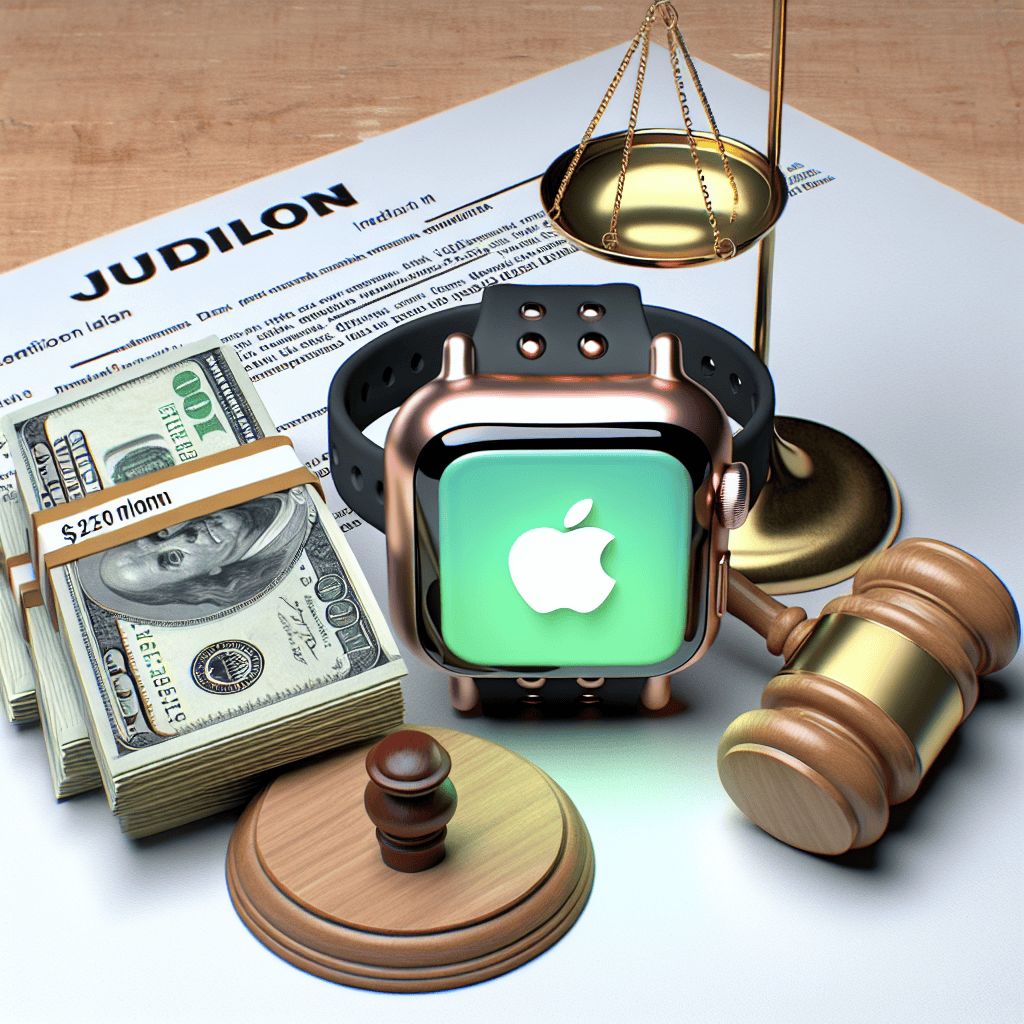“Apple Triumphs: $250 Million Verdict Secures Innovation in Masimo Smartwatch Patent Battle”
Introduction
In a significant legal victory, Apple Inc. has secured a $250 million jury verdict in a high-profile patent infringement case against Masimo Corporation. The case centered around allegations that Masimo, a medical technology company, had unlawfully utilized Apple’s patented technologies in the development of its smartwatches. The jury’s decision underscores the ongoing tensions and competitive dynamics within the tech industry, particularly in the rapidly evolving wearable technology sector. This verdict not only reinforces Apple’s intellectual property rights but also highlights the company’s commitment to protecting its innovations in a fiercely competitive market.
Overview Of The Apple Vs. Masimo Patent Dispute
In a significant legal development, Apple Inc. has secured a $250 million jury verdict in its favor in the ongoing patent dispute with Masimo Corporation, a company known for its innovative medical technology. This case, which has captured the attention of the tech and medical industries alike, revolves around allegations of patent infringement related to smartwatch technology. The verdict marks a pivotal moment in the legal battle between the two companies, underscoring the complexities and high stakes involved in patent disputes within the rapidly evolving tech landscape.
The origins of this legal confrontation can be traced back to Masimo’s claims that Apple had infringed on its patents concerning health monitoring technologies integrated into smartwatches. Specifically, Masimo alleged that Apple’s popular line of smartwatches unlawfully utilized its patented technology to measure various health metrics, such as blood oxygen levels and heart rate monitoring. These features have become increasingly important to consumers, as they offer valuable insights into personal health and wellness. Consequently, the outcome of this case holds significant implications not only for the companies involved but also for the broader tech industry, which is witnessing a surge in demand for health-focused wearable devices.
Apple, on the other hand, has consistently denied these allegations, asserting that its smartwatch technology was developed independently and does not infringe on Masimo’s patents. The company has maintained that its innovations are the result of extensive research and development efforts, aimed at providing users with cutting-edge health monitoring capabilities. Throughout the legal proceedings, Apple has emphasized its commitment to innovation and its respect for intellectual property rights, arguing that the claims made by Masimo were unfounded and lacked merit.
As the case unfolded, both parties presented extensive evidence and expert testimony to support their respective positions. The jury’s decision to award Apple a $250 million verdict suggests that they found Apple’s arguments more compelling, ultimately determining that the company did not infringe on Masimo’s patents. This outcome not only reinforces Apple’s stance but also sets a precedent for future patent disputes in the tech industry, where the boundaries of innovation and intellectual property are continually being tested.
The implications of this verdict extend beyond the immediate financial impact on Masimo. For Apple, securing this victory strengthens its position in the competitive smartwatch market, where it continues to be a dominant player. Moreover, the decision may deter future patent infringement claims against the company, as it demonstrates Apple’s ability to successfully defend its innovations in court. For Masimo, the verdict represents a setback in its efforts to protect its intellectual property, potentially prompting the company to reassess its legal strategy and explore alternative avenues for safeguarding its technological advancements.
In conclusion, the $250 million jury verdict in favor of Apple in the patent dispute with Masimo highlights the intricate nature of intellectual property battles in the tech industry. As companies strive to push the boundaries of innovation, the protection of intellectual property remains a critical concern, with legal disputes serving as a reminder of the challenges involved in navigating this complex landscape. The outcome of this case not only reaffirms Apple’s commitment to innovation but also underscores the importance of robust legal frameworks to ensure fair competition and the continued advancement of technology.
Implications Of The $250 Million Verdict On Apple’s Business
The recent $250 million jury verdict against Apple in the Masimo smartwatch patent case has significant implications for the tech giant’s business operations and strategic direction. This legal setback underscores the complexities and challenges that accompany innovation in the highly competitive technology sector. As Apple navigates the ramifications of this decision, it must consider both the immediate financial impact and the broader consequences for its product development and intellectual property strategies.
To begin with, the financial implications of the $250 million verdict are noteworthy, though not crippling for a company of Apple’s size. With a market capitalization exceeding $2 trillion, Apple possesses the financial resources to absorb such a penalty without jeopardizing its overall financial health. However, the verdict serves as a reminder of the potential costs associated with patent litigation, which can escalate quickly and unpredictably. This case highlights the importance of robust patent management and the need for companies to diligently assess the intellectual property landscape before launching new products.
Moreover, the verdict may influence Apple’s approach to future product development, particularly in the realm of wearable technology. The case centered on allegations that Apple infringed on Masimo’s patents related to health monitoring features in its smartwatches. As Apple continues to expand its offerings in the health and wellness sector, it must carefully navigate the intricate web of existing patents to avoid similar disputes. This may involve increased investment in research and development to create proprietary technologies or strategic partnerships and licensing agreements to access essential innovations.
In addition to affecting product development, the verdict could also impact Apple’s competitive positioning in the smartwatch market. The health monitoring capabilities of Apple’s smartwatches have been a key selling point, differentiating them from competitors and driving consumer interest. If the company is forced to alter or remove certain features due to patent restrictions, it could potentially weaken its market position. Consequently, Apple may need to explore alternative features or enhancements to maintain its competitive edge and continue to attract consumers.
Furthermore, the outcome of this case may prompt Apple to reassess its legal strategies and risk management practices. The tech industry is rife with patent disputes, and companies must be prepared to defend their innovations while also respecting the intellectual property rights of others. Apple may choose to bolster its legal team, enhance its patent review processes, or engage in more proactive negotiations with patent holders to mitigate the risk of future litigation.
Finally, the verdict could have broader implications for the technology industry as a whole. It serves as a cautionary tale for other companies about the importance of respecting intellectual property rights and the potential consequences of infringement. This case may encourage greater collaboration and communication among tech companies to avoid costly legal battles and foster a more cooperative environment for innovation.
In conclusion, while the $250 million jury verdict against Apple in the Masimo smartwatch patent case represents a significant legal and financial challenge, it also offers valuable lessons for the company and the broader technology industry. By carefully considering the implications of this decision, Apple can refine its strategies to better navigate the complex landscape of innovation and intellectual property, ensuring its continued success in the ever-evolving tech market.
How Patent Lawsuits Impact Innovation In The Tech Industry
In the ever-evolving landscape of the technology industry, patent lawsuits have become a common occurrence, often serving as a battleground for companies seeking to protect their intellectual property. The recent $250 million jury verdict in favor of Apple against Masimo over smartwatch patents underscores the significant role that such legal battles play in shaping the trajectory of innovation. While patent lawsuits are designed to safeguard the rights of inventors and encourage innovation by ensuring that creators can reap the benefits of their inventions, they can also have complex and sometimes contradictory effects on the tech industry.
To begin with, patent lawsuits can act as a double-edged sword. On one hand, they provide a mechanism for companies to protect their innovations from being copied or exploited without permission. This protection is crucial in an industry where research and development require substantial investment, and the competitive advantage gained from a new technology can be fleeting. By securing a favorable verdict, as Apple did against Masimo, companies can reinforce their market position and deter potential infringers, thereby encouraging further investment in innovation.
However, the impact of patent lawsuits on innovation is not entirely positive. The high costs associated with litigation can be a significant burden, particularly for smaller companies and startups that may lack the financial resources to engage in prolonged legal battles. This can stifle innovation by discouraging new entrants from developing technologies that might inadvertently infringe on existing patents. Moreover, the threat of litigation can lead to a defensive patenting strategy, where companies amass large portfolios of patents not necessarily to innovate, but to protect themselves from potential lawsuits. This can result in a patent thicket, where overlapping patents create a dense web of legal barriers that can hinder technological advancement.
Furthermore, the strategic use of patent lawsuits can sometimes be employed to stifle competition rather than to protect genuine innovation. Larger companies with extensive legal resources may use litigation as a tool to intimidate or eliminate smaller competitors, thereby reducing the diversity of ideas and slowing the pace of technological progress. This raises questions about the balance between protecting intellectual property and fostering a competitive market environment that encourages diverse innovation.
In addition to these considerations, the outcome of patent lawsuits can also influence the direction of technological development. A significant verdict, such as the one awarded to Apple, can set a precedent that shapes industry standards and practices. Companies may be prompted to alter their research and development strategies to avoid potential legal pitfalls, which can lead to shifts in the focus of innovation. While this can sometimes lead to beneficial outcomes, such as the development of alternative technologies, it can also divert resources away from potentially groundbreaking ideas.
In conclusion, while patent lawsuits are an integral part of the tech industry’s framework for protecting intellectual property, their impact on innovation is multifaceted. They can both encourage and hinder technological progress, depending on how they are used and the context in which they occur. As the industry continues to evolve, finding a balance that protects inventors while fostering a competitive and dynamic environment for innovation remains a critical challenge. The recent Apple-Masimo case serves as a reminder of the ongoing complexities and implications of patent litigation in shaping the future of technology.
The Role Of Patents In The Smartwatch Market

In the rapidly evolving landscape of wearable technology, patents play a crucial role in safeguarding innovation and ensuring that companies can protect their intellectual property. This dynamic was recently highlighted in a high-profile legal battle between Apple Inc. and Masimo Corp., culminating in a $250 million jury verdict in favor of Apple. This case underscores the significance of patents in the smartwatch market, where technological advancements are fiercely contested and intellectual property rights are vigorously defended.
Patents serve as a legal mechanism that grants inventors exclusive rights to their inventions, thereby preventing others from making, using, or selling the patented technology without permission. In the context of the smartwatch market, where companies are constantly pushing the boundaries of what these devices can do, patents are essential for fostering innovation. They provide companies with the confidence to invest in research and development, knowing that their inventions will be protected from unauthorized use by competitors.
The Apple-Masimo case is a prime example of how patents can influence the competitive dynamics within the smartwatch industry. Masimo, a company known for its expertise in non-invasive monitoring technologies, accused Apple of infringing on its patents related to health monitoring features in smartwatches. These features, which include the ability to measure blood oxygen levels and heart rate, are increasingly becoming standard in modern smartwatches, highlighting the importance of such technologies in the market.
Apple, on the other hand, argued that its innovations were developed independently and did not infringe on Masimo’s patents. The jury’s decision to award Apple $250 million reflects the complexity of patent disputes, where the line between inspiration and infringement can often be blurred. This verdict not only reinforces Apple’s position in the smartwatch market but also sends a message to other companies about the importance of securing robust patent portfolios to protect their innovations.
Moreover, this case illustrates the broader implications of patent litigation in the technology sector. Legal battles over patents can be costly and time-consuming, diverting resources away from innovation and potentially stifling competition. However, they also serve as a necessary check on the misuse of intellectual property, ensuring that companies cannot unfairly capitalize on the inventions of others. In this way, patents help maintain a level playing field, encouraging companies to develop unique and groundbreaking technologies.
As the smartwatch market continues to grow, with new players entering the field and existing companies expanding their product lines, the role of patents will only become more pronounced. Companies will need to navigate the complex web of existing patents while also securing their own to protect their innovations. This delicate balance between competition and collaboration will shape the future of the industry, driving technological advancements that benefit consumers.
In conclusion, the $250 million jury verdict in favor of Apple in the Masimo smartwatch patent case highlights the critical role that patents play in the smartwatch market. By protecting intellectual property, patents encourage innovation and ensure that companies can compete fairly. As the industry continues to evolve, the importance of securing and defending patents will remain a key factor in determining the success of companies in this highly competitive field.
Analyzing The Jury’s Decision In The Apple-Masimo Case
In a significant legal development, Apple Inc. has been ordered to pay $250 million to Masimo Corp. following a jury verdict that found the tech giant guilty of infringing on Masimo’s smartwatch patents. This case, which has captured the attention of the technology and legal communities alike, underscores the complexities and high stakes involved in patent litigation within the tech industry. The jury’s decision, reached after careful deliberation, highlights the intricate balance between innovation and intellectual property rights, a balance that is often tested in the fast-paced world of technology.
The dispute between Apple and Masimo centers around patents related to health monitoring technologies used in smartwatches. Masimo, a company known for its expertise in non-invasive monitoring technologies, accused Apple of incorporating its patented innovations into the Apple Watch without proper authorization. Specifically, the patents in question pertain to the measurement of oxygen levels in the blood, a feature that has become increasingly popular in wearable technology. As the jury examined the evidence presented by both parties, it became clear that the case was not merely about financial compensation but also about the broader implications for innovation and competition in the tech industry.
Throughout the trial, Masimo argued that Apple’s actions not only infringed on its patents but also stifled its ability to compete in the burgeoning market for health-focused wearables. This argument resonated with the jury, which ultimately sided with Masimo, awarding the company $250 million in damages. The verdict sends a strong message to tech companies about the importance of respecting intellectual property rights, even as they strive to push the boundaries of innovation. Moreover, it serves as a reminder that smaller companies with valuable patents can successfully challenge industry giants in court.
On the other hand, Apple has expressed its disappointment with the verdict and is expected to appeal the decision. The company maintains that it developed its health monitoring features independently and that the jury’s decision does not reflect the reality of its innovation process. This case, therefore, is likely to continue to unfold in the appellate courts, where the nuances of patent law and the specifics of the technologies involved will be further scrutinized. The outcome of any appeal could have significant ramifications not only for Apple and Masimo but also for the broader tech industry, as it may influence how companies approach patent development and litigation strategies in the future.
In addition to the immediate financial implications for Apple, this case also raises important questions about the role of patents in fostering or hindering innovation. While patents are designed to protect inventors and encourage the sharing of new ideas, they can also become tools for litigation that may impede technological progress. As such, the Apple-Masimo case serves as a poignant example of the ongoing debate over how best to balance the protection of intellectual property with the need to promote innovation and competition.
In conclusion, the jury’s decision in the Apple-Masimo case is a landmark moment in the realm of tech patent litigation. It underscores the critical importance of intellectual property rights while also highlighting the challenges that arise when these rights intersect with the drive for innovation. As the case progresses through potential appeals, it will undoubtedly continue to shape the landscape of patent law and its impact on the technology industry.
Future Legal Challenges For Apple In The Wearable Tech Sector
Apple’s recent $250 million jury verdict in the Masimo smartwatch patent case marks a significant moment in the ongoing legal battles within the wearable technology sector. This verdict, which found Apple liable for infringing on Masimo’s patents, underscores the complex landscape of intellectual property rights that major tech companies must navigate. As Apple continues to innovate and expand its product offerings, particularly in the competitive realm of wearable technology, it faces a myriad of legal challenges that could shape its future strategies and market position.
The case with Masimo highlights the intricate nature of patent law in the tech industry. Patents are designed to protect innovations, ensuring that inventors can reap the benefits of their creations. However, as technology evolves rapidly, the lines between original innovation and adaptation can become blurred. In this instance, Masimo, a company known for its expertise in non-invasive monitoring technology, claimed that Apple had incorporated its patented technology into the Apple Watch. The jury’s decision to award Masimo $250 million reflects the seriousness with which the legal system views patent infringement, particularly when it involves high-stakes technology.
This verdict is not an isolated incident for Apple. The company has been involved in numerous legal disputes over the years, many of which revolve around intellectual property. As Apple continues to push the boundaries of what wearable technology can do, it inevitably encounters existing patents held by other companies. This situation is not unique to Apple; it is a common challenge faced by all major players in the tech industry. However, Apple’s high profile and market dominance make it a frequent target for litigation.
Looking ahead, Apple must carefully consider its approach to research and development in the wearable tech sector. The company will need to invest in thorough patent research and possibly seek more collaborative approaches with other tech firms to avoid future legal entanglements. Moreover, Apple’s legal team will likely need to adopt more proactive strategies, such as negotiating licensing agreements or pursuing cross-licensing deals, to mitigate the risk of costly lawsuits.
Furthermore, the outcome of the Masimo case may embolden other companies to pursue legal action against Apple, potentially leading to a surge in patent-related lawsuits. This could result in a more cautious approach to innovation, as Apple may need to weigh the potential legal risks against the benefits of introducing new features or technologies. Additionally, the financial implications of such legal battles could impact Apple’s bottom line, influencing its investment decisions and pricing strategies.
In conclusion, the $250 million jury verdict in the Masimo smartwatch patent case serves as a stark reminder of the legal complexities that accompany technological innovation. As Apple continues to lead in the wearable tech sector, it must navigate these challenges with strategic foresight and legal acumen. The company’s ability to manage its intellectual property risks will be crucial in maintaining its competitive edge and ensuring its continued success in an ever-evolving market. As the tech industry progresses, the interplay between innovation and intellectual property law will remain a critical factor in shaping the future of wearable technology.
Lessons Learned From The Apple-Masimo Patent Litigation
In a significant development within the tech industry, Apple recently secured a $250 million jury verdict in a patent infringement case against Masimo, a company known for its innovative medical technology. This legal battle, centered around smartwatch technology, offers several lessons for companies navigating the complex landscape of intellectual property rights. As the case unfolded, it highlighted the importance of robust patent strategies, the intricacies of legal proceedings in the tech sector, and the broader implications for innovation and competition.
The Apple-Masimo litigation underscores the critical role that patents play in protecting technological advancements. For companies like Apple, which invest heavily in research and development, securing patents is essential to safeguarding their innovations from competitors. This case serves as a reminder that a well-defined patent portfolio can be a powerful tool in defending a company’s market position. Moreover, it illustrates the necessity for companies to conduct thorough due diligence when developing new products to ensure they do not infringe on existing patents. This proactive approach can prevent costly legal disputes and foster a more collaborative environment for technological advancement.
Furthermore, the case sheds light on the complexities of legal proceedings in the tech industry. Patent litigation is often a lengthy and expensive process, requiring substantial resources and expertise. Companies must be prepared to engage in detailed technical analyses and present compelling evidence to support their claims. The Apple-Masimo case exemplifies how intricate and nuanced these legal battles can be, with both parties presenting sophisticated arguments to defend their positions. This complexity underscores the need for companies to have a strong legal team with specialized knowledge in intellectual property law to navigate these challenges effectively.
In addition to the legal intricacies, the case also highlights the broader implications for innovation and competition within the tech industry. While patent protection is crucial for encouraging investment in new technologies, it can also lead to disputes that may stifle innovation. The Apple-Masimo verdict raises questions about the balance between protecting intellectual property and fostering an open environment for technological development. Companies must navigate this delicate balance to ensure that their pursuit of patent protection does not hinder the overall progress of the industry.
Moreover, the outcome of this case may influence future collaborations and partnerships within the tech sector. As companies strive to bring cutting-edge products to market, they may need to consider strategic alliances to mitigate the risk of patent disputes. By working together, companies can pool their resources and expertise to drive innovation while minimizing the potential for legal conflicts. This collaborative approach could lead to more efficient development processes and a more dynamic technological landscape.
In conclusion, the Apple-Masimo patent litigation offers valuable insights into the challenges and opportunities associated with intellectual property in the tech industry. It emphasizes the importance of a comprehensive patent strategy, the complexities of legal proceedings, and the need for a balanced approach to innovation and competition. As the tech landscape continues to evolve, companies must remain vigilant in protecting their intellectual property while fostering an environment that encourages collaboration and technological advancement. The lessons learned from this case will undoubtedly shape the strategies of tech companies as they navigate the ever-changing world of innovation and intellectual property rights.
Q&A
1. **What was the case about?**
The case involved a patent infringement lawsuit where Masimo claimed that Apple had infringed on its patents related to smartwatch technology.
2. **Who were the parties involved?**
The parties involved were Apple Inc. and Masimo Corporation.
3. **What was the outcome of the case?**
Apple was ordered to pay $250 million to Masimo as a result of the jury’s verdict.
4. **What technology was at the center of the dispute?**
The dispute centered around health monitoring technology used in smartwatches, specifically related to sensors and algorithms.
5. **Which court handled the case?**
The case was handled in a U.S. federal court.
6. **What was Apple’s response to the verdict?**
Apple expressed disappointment with the verdict and indicated plans to appeal the decision.
7. **How might this verdict impact Apple’s future product development?**
The verdict could lead Apple to reassess its use of certain technologies in its products and potentially seek licensing agreements or develop alternative solutions.
Conclusion
The conclusion of the case where Apple secured a $250 million jury verdict in the Masimo smartwatch patent dispute highlights the complexities and high stakes involved in intellectual property litigation within the tech industry. This outcome underscores Apple’s commitment to defending its innovations and intellectual property against claims of infringement. The verdict may also serve as a precedent for future patent disputes, influencing how companies approach the development and protection of their technological advancements. Additionally, the case reflects the ongoing competitive tensions in the wearable technology market, where companies are aggressively protecting their market share and technological innovations.





